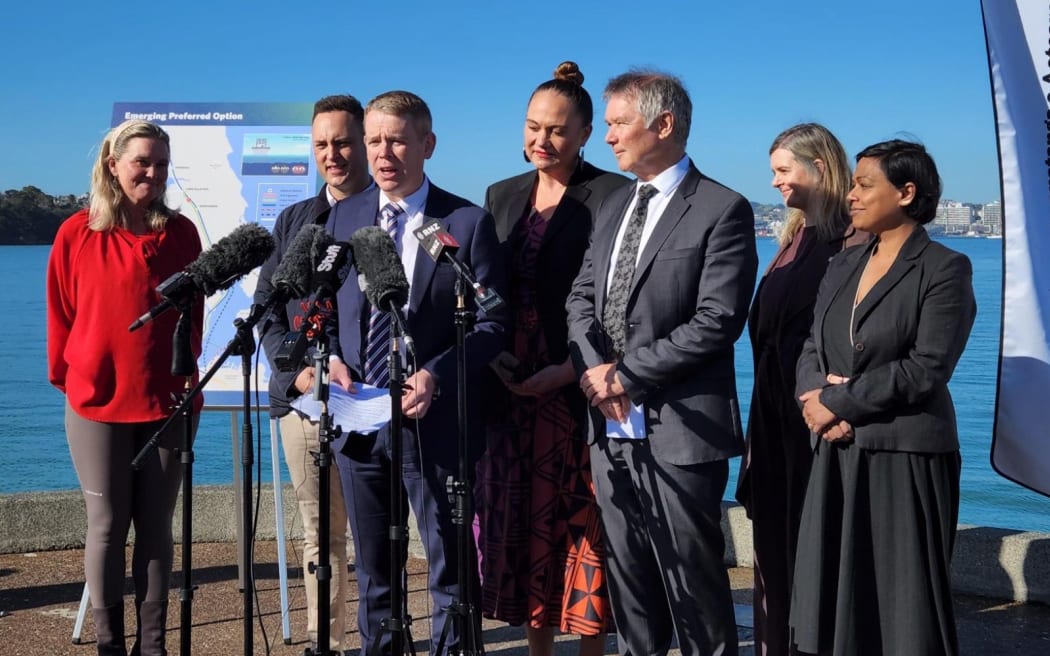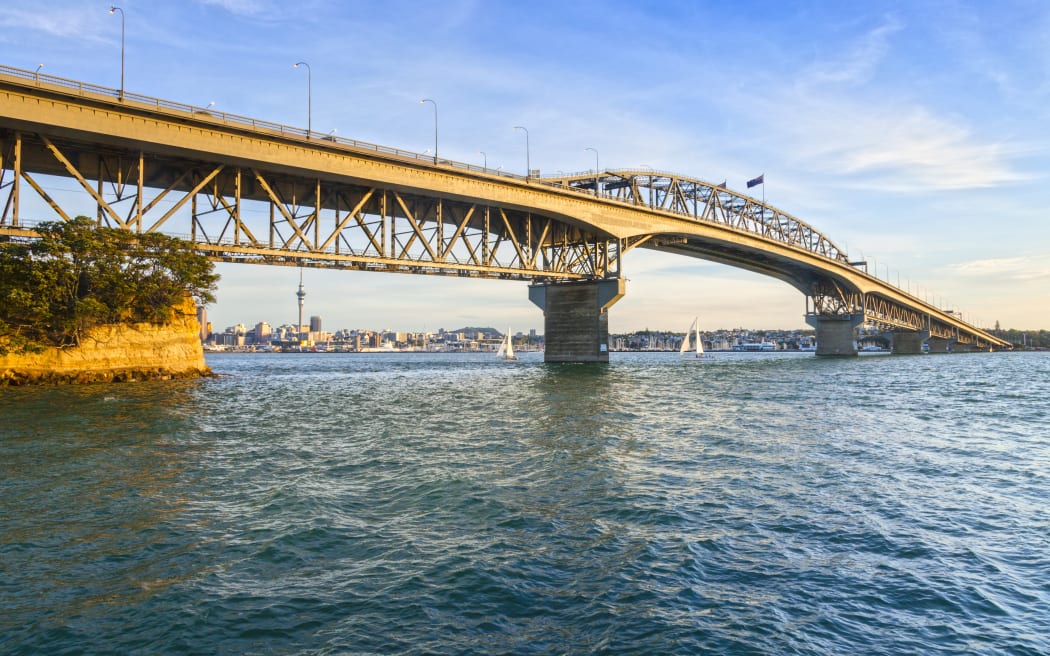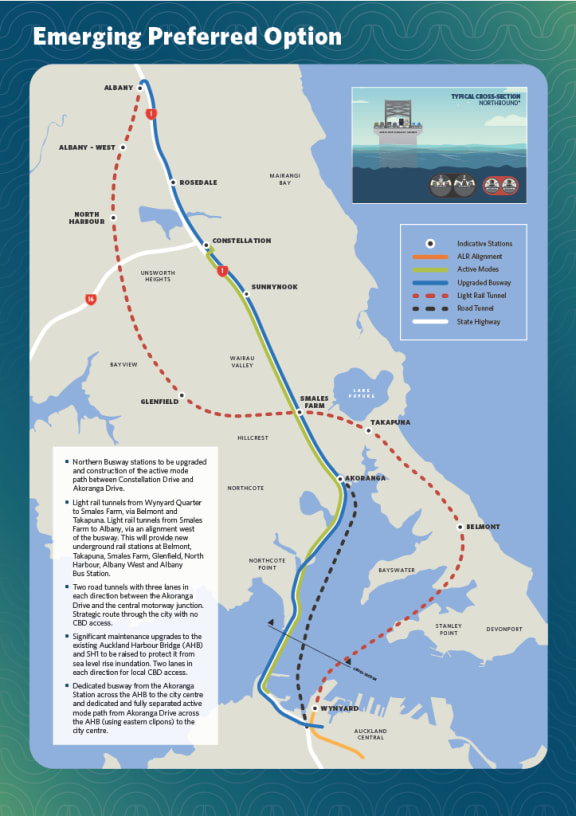[ad_1]

Chris Hipkins, David Parker and Carmel Sepuloni at the announcement of the plan on 6 August.
Photo: Lucy Xia / RNZ
Auckland would get three tunnels across Waitematā Harbour – two for vehicles and one for light rail – under new plans revealed by the government today.
Prime Minister Chris Hipkins, Transport Minister David Parker and Deputy Prime Minister Carmel Sepuloni presented the ambitious plan, expected to cost up to $45 billion and built over decades, at North Shore’s Bayswater Marina.
The two road tunnels would be three lanes each, one-way, and go from the CBD to Akoranga – about five or six kilometres, twice as long as the Waterview Tunnel.
The light rail tunnel would stretch 21km, going from Wynyard Quarter all the way north to Albany, winding through Takapuna and Belmont, stopping in six places.
“This is a bold plan for Auckland’s future that delivers a modern transport network that will connect all parts of the city,” Hipkins said.
“Reducing congestion requires improvements to both roading and public transport, giving the public choice. Under this proposal the network will become joined up, allowing Aucklanders to travel from the north to the south, east and west on public transport – freeing up room on the existing Harbour Bridge and in the new road tunnel for those who want to drive.
“A second harbour crossing is needed as soon as possible, and construction is planned to start by the end of this decade and why we are proposing a phased approach, ensuring additional capacity is achieved after each stage.”
Hipkins said the recent closures of the existing bridge due to weather-related issues “illustrate the city’s vulnerability to interruptions”.
“These new tunnels future-proof the city’s transport network by reducing reliance on the Harbour Bridge while creating fast new options for getting in and out of the city.”

The existing Harbour Bridge.
Photo: 123rf
Some lanes on the existing Harbour Bridge would be set aside for buses and cycling/walking. Four lanes would be kept for typical traffic. An elevated walking path to keep pedestrians and cyclists apart is also being considered.
Construction was expected to begin in 2029, starting with the road tunnels.

A map showing Waka Kotahi’s preferred option for light rail.
Photo: Waka Kotahi / Supplied
A range of ways to fund it were being considered, including targeted levies on properties that stood to gain in value and congestion charges.
“We could afford the Harbour Bridge in 1959, when Auckland’s population was only 430,000, so we can afford a second crossing that will modernise transport for the city’s residents and the millions of people who visit every year,” Hipkins said.
Allocated bus lanes on the existing bridge and directing more traffic to the tunnels would allow the Northern Busway to extend into the CBD, Parker said.
“Without it the northern motorway and the bridge would already be completely clogged at peak times.”
“The twin-tunnel connection would allow the busway to be extended across dedicated lanes on the Harbour Bridge into the CBD. This is essential to maximising the value of other important investments such as City Rail Link currently under construction.”
Waka Kotahi estimated public transport travel times from Takapuna into the city would be improved by 20 percent under this plan, and from Albany to the CBD by 21 percent. By 2051 it would increase public transport harbour crossings by 275 percent.
As well as the tunnels and lane reprioritisations, the project would include raising State Highway 1 on the North Shore to reduce flooding risk.
The government’s pick was the most ambitious of a range of options looked at by Waka Kotahi.
“Waka Kotahi will also report back to Cabinet next year with a detailed plan for how the elements of the cross harbour plans can be phased and funded,” Parker said.
“With a project of this scale we will need to keep an open mind to funding options. We are seeking advice from Waka Kotahi on this.”
Indicative costs:
- Road tunnels: $12-15 billion
- SH1 improvements: $1.0-1.5 billion
- Northern Busway upgrades: $0.5 billion
- Walking and cycling improvements: $0.5 billion
- Light rail tunnel (CBD to North Shore): $8.5-11 billion
- Light rail tunnel (North Shore to Albany): $12.5-16 billion
- Overall cost: $35-45 billion
National Party transport spokesperson Simeon Brown called it a “desperate announcement” that doubled the cost of existing light rail plans.
“Labour promised light rail to Mt Roskill by 2021 but has yet to deliver a single metre of track, even after spending more than $140 million on consultants.
“After six years of reports, promises, studies, consultations and announcements, Labour admitted this week it hasn’t even finished a business case for light rail to the airport. Transport Minister David Parker has no idea which route it will take.
“Aucklanders cannot ride on your ghost train, Mr Parker.”
He said it left a “$60 billion hole” in Labour’s costings. But he did not rule out keeping the new tunnel plans.
“When in government, National will look closely at the proposed tunnels across the Waitematā Harbour, as a second harbour crossing is a critical part of Auckland’s future.”
The Green Party has called the plan bonkers.
Co-leader James Shaw said the government seemed to have a tendency to choose the most expensive and over-engineered plans possible.
“I don’t think that six lanes of traffic are going to solve Auckland’s congestion problem. Frankly, during a climate crisis it’s a bit bonkers to be building more roads and inducing more traffic and more car dependency.”
Shaw said at the very least, the light rail tunnel should be built first to reduce congestion, and indicate what roading demand there is.
[ad_2]
Source link
